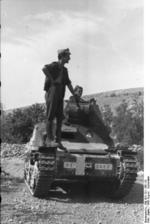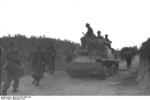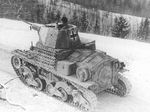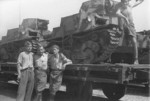L6/40
| Country | Italy |
| Manufacturer | Fiat |
| Primary Role | Light Tank |
Contributor: Alan Chanter
ww2dbaseThe Fiat L6/40 arose from a 1936 demand for a heavier vehicle than the L3 series of tankettes produced by Fiat-Ansaldo of Turin, Italy in the early 1930s. As the L3 had performed satisfactory in Abyssinia (Ethiopia) during 1935-1936 and demonstrated that tanks could be employed in mountainous terrain, the new vehicle was designed primarily as a scaled up version of Fiat's CV (Carro Veloce, or Fast Tank) 33 Tankette with a modified chassis that incorporated torsion-bar suspension (replacing the British type Carden-Loyd suspension principle that had been used on the CV 33) and with two pairs of double road wheels each side driving the tracks. Armour protection was greatly improved and consisting of flat plates bolted and riveted together (although little attention was paid to sloping the armour), and the tank was given a more powerful 70 hp Spa four-cylinder engine which, despite an increase in overall vehicle weight to 6.8 tons, proved more than adequate to permit the L6 to operate at the same speed as its lighter predecessor.
ww2dbaseIntended initially for the export market, the first prototype was completed in 1936, but production did not begin until 1939 after the Italian Army had placed an order for 280 vehicles for service with reconnaissance and cavalry units. The L6 was initially intended to be armed with either two machine guns or one machine gun and a 37 mm cannon, but the Italian Army opted for a 20 mm Breda model 35 cannon with coaxially mounted 8 mm Breda Model 38 machine gun, mounted in a small one-man turret, for their vehicles. All vehicles were fitted with radio as standard equipment.
ww2dbaseDeliveries commenced in 1940 (hence the designation of L6/40) but production was slow and it was not available in significant numbers until 1942, by which time it was well out-of-date and not really suitable for front line service. Most of the L6/40s were employed in North Africa (generally, but not invariably, in a reconnaissance role). A small number saw service in Yugoslavia, and a contingent that was sent to Russia did not return. Although roughly equivalent to the German PzKpfw II, a crew of just two men and rather too light armament made the L6/40 far less successful in combat. Nevertheless, after Italy's surrender in 1943, L6/40s held in reserve in Italy were seized by the German Army for use against partisan guerrilla bands.
ww2dbaseSome L6/40s were modified as flame-throwers with the 20 mm gun replaced by a projector and 200 litres (44 gallons) of fuel carried in a drum on the back. Others were fitted out as command tanks, with extra communications equipment in an open topped turret.
ww2dbaseWhen battlefield experience began to show the declining importance of the light tank family, L6/40 production was turned over to the manufacture of a self-propelled anti-tank gun, the Semovente L40, based on the same chassis. The conversion consisted of mounting the superb Model 47/32 anti-tank gun in a fixed box superstructure (closely resembling that of the CV 33) with a light roof over the crew compartment. With its crew of three (driver and two gun operators) the Semovente carried eighty-nine rounds of 47 mm ammunition for the gun which was pivoted in a mantlet in the front plate to the left of the driver. For immediate protection a 6.5 mm machine gun could be brought into action from the roof. It was hoped to mount all anti-tank guns on these chassis, but production never caught up and of the 280 machines assembled between 1941 and 1942 most were sent to bolster the anti-tank units of the Italian armoured units in North Africa, because there was nothing else suitable.
ww2dbaseUltimately about 500 L6 series vehicles were built, and although a considerable improvement on its L3 predecessor it was, like most Italian tanks in World War II, hopelessly outclassed when it came up against Allied armour. The surviving German-seized tanks were eventually returned to Italy after the end of hostilities.
ww2dbaseSources:
Ian V. Hogg & John Weeks, The Illustrated Encyclopedia of Military Vehicles (Hamlyn, 1980)
Brian Perrett, Italian Tanks and SP Guns (War Monthly Issue 68)
Philip Trewhitt, Armoured Fighting Vehicles (Dempsey-Parr, 1999)
B. T. White, Tanks and other AFVs of the Blitzkrieg Era 1939-41 (Blandford Press, 1972)
Last Major Revision: Jan 2013
SPECIFICATIONS
L6/40
| Machinery | One 4,053cc SPA 18D 4-cyl inline water cooled petrol engine rated at 70bhp at 2,500rpm |
| Suspension | Torsion-bar with two pairs of double road wheels on each track |
| Armament | 1x20mm Breda model 35 cannon, 1x8mm coaxial Breda model 38 machine gun |
| Armor | 6-30mm |
| Crew | 2 |
| Length | 3.78 m |
| Width | 1.92 m |
| Height | 2.03 m |
| Weight | 6.8 t |
| Speed | 42 km/h |
| Range | 200 km |
Photographs
 |  |  |  |
Please consider supporting us on Patreon. Even $1 per month will go a long way! Thank you. Please help us spread the word: Stay updated with WW2DB: |
- » US Women's Army Corps "Six Triple Eight" Awarded with Congressional Gold Medal (30 Apr 2025)
- » Wreck of Soviet Submarine M-49 Found (10 Apr 2025)
- » Japanese Emperor Visited Iwoto (Iwo Jima) (8 Apr 2025)
- » Race, Holocaust, and African-American WW2 Histories Removed from the US Naval Academy Library (7 Apr 2025)
- » US Government Plans to Purge WW2 Information (17 Mar 2025)
- » See all news
- » 1,167 biographies
- » 337 events
- » 44,617 timeline entries
- » 1,244 ships
- » 350 aircraft models
- » 207 vehicle models
- » 376 weapon models
- » 123 historical documents
- » 261 facilities
- » 470 book reviews
- » 28,519 photos
- » 365 maps
General Douglas MacArthur at Leyte, 17 Oct 1944
Please consider supporting us on Patreon. Even $1 a month will go a long way. Thank you!
Or, please support us by purchasing some WW2DB merchandise at TeeSpring, Thank you!